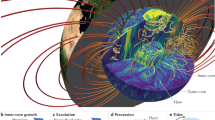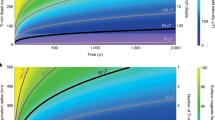Abstract
Lunar rocks contain a record of an ancient magnetic field that seems to have persisted for more than 400 million years1,2 and which has been attributed to a lunar dynamo3,4. Models of conventional dynamos driven by thermal or compositional convection have had difficulty reproducing the existence and apparently long duration of the lunar dynamo5,6,7. Here we investigate an alternative mechanism of dynamo generation: continuous mechanical stirring arising from the differential motion, due to Earth-driven precession of the lunar spin axis, between the solid silicate mantle and the liquid core beneath8,9. We show that the fluid motions and the power required to drive a dynamo operating continuously for more than one billion years and generating a magnetic field that had an intensity of more than one microtesla 4.2 billion years ago3 are readily obtained by mechanical stirring. The magnetic field is predicted to decrease with time and to shut off naturally when the Moon recedes far enough from Earth that the dissipated power is insufficient to drive a dynamo; in our nominal model, this occurred at about 48 Earth radii (2.7 billion years ago). Thus, lunar palaeomagnetic measurements may be able to constrain the poorly known early orbital evolution of the Moon. This mechanism may also be applicable to dynamos in other bodies, such as large asteroids.
This is a preview of subscription content, access via your institution
Access options
Subscribe to this journal
Receive 51 print issues and online access
$199.00 per year
only $3.90 per issue
Buy this article
- Purchase on Springer Link
- Instant access to full article PDF
Prices may be subject to local taxes which are calculated during checkout


Similar content being viewed by others
References
Cisowski, S. M., Collinson, D. W., Runcorn, S. K. & Stephenson, A. A review of lunar paleointensity data and implications for the origin of lunar magnetism. J. Geophys. Res. 88, A691–A704 (1983)
Wieczorek, M. A. et al. in New Views of the Moon (eds Jolliff, B. L., Wieczorek, M. A., Shearer, C. K. & Neal, C. R.) 60, 221–364 (Mineralogical Soceitry of America, 2006)
Garrick-Bethell, I., Weiss, B. P., Shuster, D. L. & Buz, J. Early lunar magnetism. Science 323, 356–359 (2009)
Hood, L. L. Central magnetic anomalies of Nectarian-aged lunar impact basins: probable evidence for an early core dynamo. Icarus 211, 1109–1128 (2011)
Stegman, D. R., Jellinek, A. M., Zatman, S. A., Baumgardner, J. R. & Richards, M. A. An early lunar core dynamo driven by thermochemical mantle convection. Nature 421, 143–146 (2003)
Takahashi, F. & Tsunakawa, H. Thermal core-mantle coupling in an early lunar dynamo: implications for a global magnetic field and magnetosphere of the early Moon. Geophys. Res. Lett. 36, L24202 (2009)
Konrad, W. & Spohn, T. Thermal history of the Moon: implications for an early core dynamo and post-accretional magmatism. Adv. Space Res. 19, 1511–1521 (1997)
Yoder, C. F. The free librations of a dissipative Moon. Phil. Trans. R. Soc. Lond. A 303, 327–338 (1981)
Williams, J. G., Boggs, D. H., Yoder, C. F., Ratcliff, J. T. & Dickey, J. O. Lunar rotational dissipation in solid body and molten core. J. Geophys. Res. 106, 27933–27968 (2001)
Weber, R. C., Lin, P.-Y., Garnero, E. J., Williams, Q. & Lognonné, P. Seismic detection of the lunar core. Science 331, 309–312 (2011)
Hood, L. L. & Artemieva, N. A. Antipodal effects of lunar basin-forming impacts: initial 3D simulations and comparisons with observations. Icarus 193, 485–502 (2008)
Lawrence, K., Johnson, C., Tauxe, L. & Gee, J. Lunar paleointensity measurements: implications for lunar magnetic evolution. Phys. Earth Planet. Inter. 168, 71–87 (2008)
Nimmo, F. in Core Dynamics (ed. Olson, P.) 31–65 (Treatise on Geophysics 8, Academic, 2007)
Goldreich, P. Precession of the Moon’s core. J. Geophys. Res. 72, 3135–3137 (1967)
Meyer, J. & Wisdom, J. Precession of the lunar core. Icarus 211, 921–924 (2011)
Tilgner, A. Precession-driven dynamos. Phys. Fluids 17, 034104 (2005)
Peale, S. J. Generalized Cassini’s laws. Astron. J. 74, 483–489 (1968)
Ward, W. R. Past orientation of the lunar spin axis. Science 189, 377–379 (1975)
Williams, G. E. Geological constraints on the Precambrian history of Earth’s rotation and the Moon’s orbit. Rev. Geophys. 38, 37–59 (2000)
Webb, D. J. Tides and the evolution of the Earth-Moon system. Geophys. J. R. Astron. Soc. 70, 261–271 (1982)
Cébron, D., Maubert, P. & Le Bars, M. Tidal instability in a rotating and differentially heated ellipsoidal shell. Geophys. J. Int. 182, 1311–1318 (2010)
Roberts, P. H., Glatzmaier, G. A. & Clune, T. L. Numerical simulation of a spherical dynamo excited by a flow of von Karman type. Geophys. Astrophys. Fluid Dyn. 104, 207–220 (2010)
Christensen, U. R., Holzwarth, V. & Reiners, A. Energy flux determines magnetic field strength of planets and stars. Nature 457, 167–169 (2009)
Ong, L. & Melosh, H. J. in 41st Lunar Planet. Sci. Conf. abstr. 1363, 〈http://www.lpi.usra.edu/meetings/lpsc2010/pdf/1363.pdf〉 (Lunar and Planetary Institute, 2010)
Le Bars, M., Wieczorek, M. A., Karatekin, Ö., Cébron, D. & Laneuville, M. An impact-driven dynamo for the early Moon. Nature 〈http://dx.doi.org/10.1038/nature10565〉 (this issue)
Ooe, M., Sasaki, H. & Kinoshita, H. in Variations in Earth Rotation (eds McCarthy, D. D. & Carter, W. E. ) 51–57 (American Geophysical Union, 1990)
Walker, J. C. G. et al. in Earth’s Earliest Biosphere (ed. Schopf, J. ) 260–290 (Princeton Univ. Press, 1983)
Zahnle, K. et al. Emergence of a habitable planet. Space Sci. Rev. 129, 35–78 (2007)
Weiss, B. P. et al. Magnetism on the angrite parent body and the early differentiation of planetesimals. Science 322, 713–716 (2008)
Bills, B. G. & Nimmo, F. Forced obliquities and moments of inertia of Ceres and Vesta. Icarus 213, 496–509 (2011)
Canup, R. M. & Asphaug, E. Origin of the Moon in a giant impact near the end of the Earth’s formation. Nature 412, 708–712 (2001)
Acknowledgements
C.A.D. would like to thank B. P. Weiss and I. Garrick-Bethell for discussions.
Author information
Authors and Affiliations
Contributions
D.J.S. thought of the initial idea. C.A.D. performed the calculations. F.N. investigated the conditions under which turbulence occurs. All authors discussed the results and implications and commented on the manuscript.
Corresponding author
Ethics declarations
Competing interests
The authors declare no competing financial interests.
Supplementary information
Supplementary Information
This file contains Supplementary Discussions 1-3, Supplementary Figures 1-3 with legends, Supplementary Tables 1-2 and additional refernces. (PDF 419 kb)
PowerPoint slides
Rights and permissions
About this article
Cite this article
Dwyer, C., Stevenson, D. & Nimmo, F. A long-lived lunar dynamo driven by continuous mechanical stirring. Nature 479, 212–214 (2011). https://doi.org/10.1038/nature10564
Received:
Accepted:
Published:
Issue Date:
DOI: https://doi.org/10.1038/nature10564
This article is cited by
-
An episodic high-intensity lunar core dynamo
Nature Astronomy (2022)
-
Electrical resistivity of the Fe–Si–S ternary system: implications for timing of thermal convection shutdown in the lunar core
Scientific Reports (2022)
-
Fluid Dynamics Experiments for Planetary Interiors
Surveys in Geophysics (2022)
-
Interiors of Earth-Like Planets and Satellites of the Solar System
Surveys in Geophysics (2022)
-
The palaeoinclination of the ancient lunar magnetic field from an Apollo 17 basalt
Nature Astronomy (2021)
Comments
By submitting a comment you agree to abide by our Terms and Community Guidelines. If you find something abusive or that does not comply with our terms or guidelines please flag it as inappropriate.



